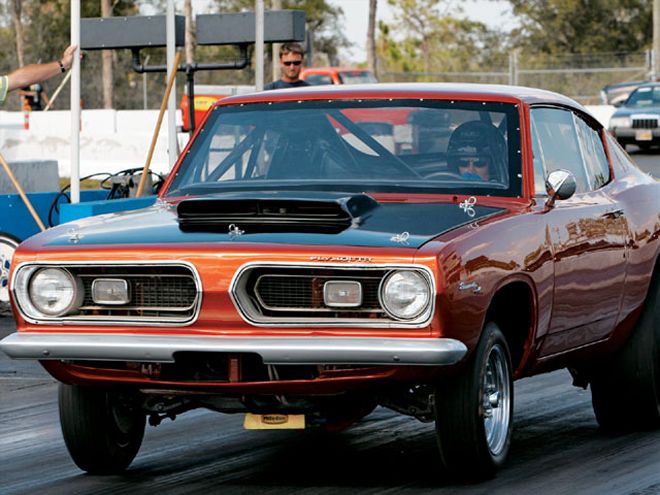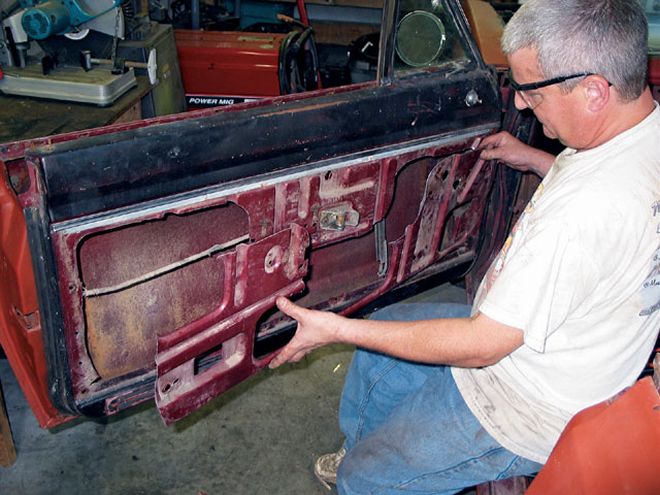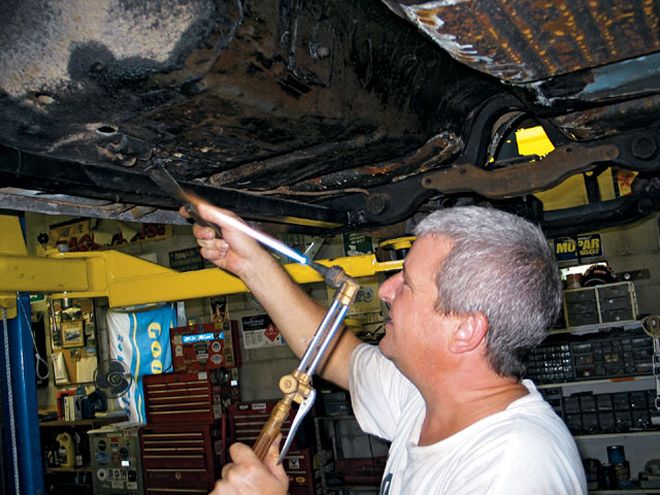
 After adding the weight of a rollcage, frame connectors, and other safety equipment to our project Barracuda, we needed to lighten it up. Follow along as we show you some economical ways to shave pounds from your street or bracket car by removing unnecessary accessories, installing polycarbonate windows, and replacing steel parts with fiberglass.
After adding the weight of a rollcage, frame connectors, and other safety equipment to our project Barracuda, we needed to lighten it up. Follow along as we show you some economical ways to shave pounds from your street or bracket car by removing unnecessary accessories, installing polycarbonate windows, and replacing steel parts with fiberglass.
It has long been known that a car's power-to-weight ratio is a good indicator of how a vehicle will perform at the track. As a standard rule of thumb in drag racing, a one-hundred-pound decrease in weight will shave approximately 1/10 of one second from a car's elapsed time in the quarter-mile. Since a tenth of a second is approximately equal to one car length, it makes sense to make your car as light as possible if performance is your goal. Because performance is definitely the goal of our Barracuda project car, and since we added the weight of a rollcage, frame connectors, and torque boxes, we'll show you how we lightened it back up by removing unnecessary equipment, replacing the glass windows with lightweight polycarbonate, and adding fiberglass body components.
 Since we removed our glass windows and window regulators, we only need the inner structure of the door to support the door release handle. The rest of the metal can be cut out to save weight. Again, the weight reduction is minimal, but when combined with everything else it does make a difference.
Since we removed our glass windows and window regulators, we only need the inner structure of the door to support the door release handle. The rest of the metal can be cut out to save weight. Again, the weight reduction is minimal, but when combined with everything else it does make a difference.
Lightening a race car, or street car for that matter, always involves walking the line between safety, structural integrity, and weight. When building a car for the track like we are, a rollcage is mandated by both the NHRA sanctioning body and common sense. If we want to be safe and run on sanctioned tracks, we must install a legal rollcage in our car. Since we're installing a fairly powerful big-block in our A-body, we deemed it necessary to add frame connectors and torque boxes as well. With all this extra steel, we'd be hard pressed to get the weight of our Barracuda below its factory shipping weight, but we can fairly easily negate the weight we added by lightening the remainder of the car. A good place to start this lightening process is by removing any unneeded equipment from the vehicle.
Since our Barracuda will only see time at the track, we won't need the luxuries of windshield wipers or a heater, so those items and their associated hardware will be removed. Additionally, we'll be removing the glass side windows, so the window regulators and a significant portion of the inner door metal can be cut away. Since we'll be using a lightweight fuel cell located in the trunk, the heavy factory fuel tank will also be discarded. If you really want to get carried away, lightening holes can be drilled in any nonstructural parts of the car. This process is labor intensive, and is really only justifiable when building a truly dedicated race car that needs to be as light as possible. Since our car is a bracket racer, we won't go to this extreme.
 Since it doesn't cost anything but time, we spent a while scraping the undercoating off our car. Again, weight reduction seems insignificant, but every ounce helps.
Since it doesn't cost anything but time, we spent a while scraping the undercoating off our car. Again, weight reduction seems insignificant, but every ounce helps.
Replacing some of the steel outer body panels with fiberglass parts is another way we'll shave pounds from our bracket racer. Remember though, some replacement fiberglass body parts are flimsy and poorly made. While these types of replacement panels will save weight, chances are they won't fit well, and they certainly won't last through the abuses of drag racing. Knowing that we needed to find good-quality fiberglass, we called our friends at AAR Quality Fiberglass and ordered a hood, trunk lid, and both bumpers for our Barracuda. The AAR parts are exceptionally well built, with reinforcing braces molded into the underside. The finish of the AAR parts is also outstanding. the parts come ready for final sanding and paint; there is no trimming or bodywork required. By ordering a pin-on hood and decklid, we'll be able to save additional weight by eliminating the hood, trunk hinges, and latching mechanisms.
The final way we'll save weight from our car is to replace all the glass windows with lightweight polycarbonate material. The glass, especially the rear window of our fastback, is very heavy, which makes this one of the best techniques to save weight. Even if you've never fabricated and installed polycarbonate windows, you can do the job easily with tools you already have in your shop. The material is available from any home-improvement store and is easy to handle, cutting easily with a jigsaw. By using the factory glass as templates, you can replace all the glass in your race car in a weekend, shaving significant weight in the process.
Also, don't forget about the most important type of weight: reciprocating weight. A reduction in reciprocating weight can have an exponential effect, freeing horsepower to propel the car forward. Lightweight pistons, rods, and valvetrain components all help free up horsepower in the engine, and lightweight driveline components require less power to turn, thereby putting more power to the rear wheels. Speaking of wheels, lightweight rolling stock is a benefit to any race or street car.
While we didn't weigh the items we removed from our car individually, we did weigh the car when it was completed and in race trim. On the scales, without a driver but otherwise ready to race, our Barracuda weighed 2,878 pounds. Knowing that a factory '67 Barracuda's shipping weight was approximately 2,900 pounds, we basically negated the 200 pounds of rollcage and 50 pounds of frame connectors and torque boxes, getting our car back down to its factory weight. While this doesn't sound like much, remember that every hundred pounds equals a tenth of a second, or about a car length, which could mean the difference between a win and a loss. Additionally, by reducing the weight of our car, the load on the engine and drivetrain is reduced, thereby lengthening the service life of our components.